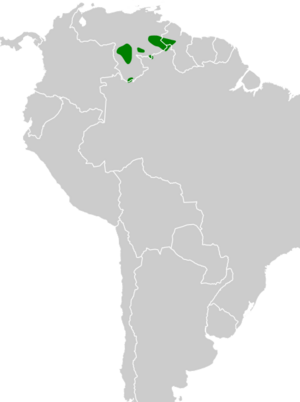Tepui foliage-gleaner facts for kids
Quick facts for kids Tepui foliage-gleaner |
|
|---|---|
 |
|
| Conservation status | |
| Scientific classification | |
| Genus: |
Syndactyla
|
| Species: |
roraimae
|
 |
|
| Synonyms | |
|
|
The tepui foliage-gleaner (scientific name: Syndactyla roraimae) is a small bird. It is also known as the white-throated foliage-gleaner. This bird belongs to the ovenbird family, which is called Furnariidae. You can find it in parts of Brazil, Guyana, and Venezuela.
Contents
About the Tepui Foliage-Gleaner
Scientists group living things into families and genuses. The tepui foliage-gleaner was first placed in the Philydor group. Later, it was moved to the Automolus group. But in 2008 and 2011, new studies showed it really belongs in the Syndactyla group.
There are four different types, or subspecies, of the tepui foliage-gleaner:
- S. r. paraquensis (discovered by Phelps, 1947)
- S. r. duidae (discovered by Chapman, 1939)
- S. r. roraimae (discovered by Hellmayr, 1917)
- S. r. urutani (discovered by Phelps Jr & Dickerman, 1980)
What Does the Tepui Foliage-Gleaner Look Like?
This bird is about 18 centimeters (7 inches) long. It weighs between 22 and 32 grams (0.78 to 1.1 ounces). It is the smallest bird in its group. It also has a very clear face pattern. Male and female birds look the same.
The most common type, S. r. roraimae, has a white stripe above its eye. This stripe stands out against its dark face. Its head is dark grayish-brown. Its back is a rich, dark reddish-brown. The rump and tail feathers are a bright reddish-brown. Its tail is also reddish-brown.
Its throat and cheek area are white. The chest and belly are medium brown. The sides and under-tail feathers are darker brown. Its eyes are brown. The top part of its beak is black. The bottom part of its beak can be pinkish-gray to black. Its legs and feet are olive-yellow to greenish-gray. Young birds have a yellowish stripe above their eyes. Their underparts are more reddish than adult birds.
Other subspecies have slightly different colors:
- S. r. paraquensis has a lighter, more yellowish-brown back. Its chest and belly are lighter and more grayish-olive.
- S. r. duidae has a more reddish head. Its underparts are also more reddish, with a much brighter belly.
- S. r. urutani is lighter overall than the other types. It is less reddish on top and less yellowish underneath.
Where Does the Tepui Foliage-Gleaner Live?
This bird lives in the tepui region. This is where eastern Venezuela, western Guyana, and northwestern Brazil meet. The different subspecies live in separate areas:
- S. r. paraquensis: Lives on Cerro Paraque in south-central Venezuela.
- S. r. duidae: Found on several tepuis in Venezuela. Also on Cerro de la Neblina, which is on the Venezuela/Brazil border.
- S. r. roraimae: Lives on Mount Roraima. This mountain is where Venezuela, Guyana, and Brazil meet. It also lives on other tepuis in southeastern Venezuela and western Guyana.
- S. r. urutani: Found on several tepuis in Venezuela's Bolívar state.
The tepui foliage-gleaner lives in mountain evergreen forests. It also lives in woodlands where trees are short due to wind. It likes the areas where these two types of forests meet. It usually lives at heights between 1,100 and 2,500 meters (3,600 to 8,200 feet).
Behavior and Habits
Movement
The tepui foliage-gleaner stays in its home area all year long. It does not migrate.
Feeding Habits
This bird eats many kinds of arthropods, like beetles and grasshoppers. It usually looks for food alone or in pairs. Sometimes, small family groups will forage together. It often joins groups of different bird species that are feeding.
It mostly searches for food in the lower parts of the forest. But it can also go higher into the middle parts of the trees. It stays low in the bushes and vines. It also climbs along branches and up tree trunks. It finds its food by picking insects from leaves, moss, and branches. Sometimes, it even hangs upside down to get food!
Reproduction
We don't know much about how the tepui foliage-gleaner reproduces. In Guyana, their breeding season seems to end in March or April.
Vocalization
The song of the tepui foliage-gleaner is a long, fast series of harsh, gurgling "jjza" notes. The sound gets higher in pitch. It usually starts with a few short, single notes. Its call is a short, harsh "chek" or "tzik" sound.
Conservation Status
The IUCN (International Union for Conservation of Nature) has said the tepui foliage-gleaner is of "Least Concern." This means it is not currently in danger of disappearing. It lives in a specific area, and we don't know exactly how many there are. But scientists believe its population is stable. There are no immediate threats to this bird. It is seen as uncommon to common in different places. It also lives in one national park in Venezuela.


